Engine Malfunctioning Conditions Identification through Instantaneous Crankshaft Torque Measurement Analysis
Abstract
1. Introduction
- Change in the Start of Injection (SOI); occurs due to fuel injector wear and engine detuning [32].
- Change in the scavenge air pressure; occurs due to turbocharger compressor or scavenge air cooler fouling [34].
2. Methods and Tools
2.1. Reference System & Methodology
2.2. Thermodynamic Model Description
2.3. Crankshaft Dynamics Model
2.4. Malfunctioning Conditions Modelling
3. Results & Discussion
3.1. Healthy Engine Conditions
3.2. Malfunctioning Engine Conditions
3.3. Frequency Analysis and Malfunctioning Conditions Mapping
4. Conclusions
Author Contributions
Funding
Acknowledgments
Conflicts of Interest
Abbreviations
| ANN | Artificial Neural Network |
| DOF | Degree of Freedom |
| EVC | Exhaust Valve Close |
| FFT | Fast Fourier Transform |
| ICS | Instantaneous Crankshaft Speed |
| ICT | Instantaneous Crankshaft Torque |
| MCR | Maximum Continuous Rating |
| NRMSE | Normalised Root Mean Squared Error |
| RHR | Rate of Heat Release |
| SOI | Start of Injection |
| SPO | Scavenge Port Open |
| SVM | Support Vector Machine |
| TDC | Top Dead Center |
| VIT | Variable Injection Timing |
References
- Kyrtatos, N.P. From Hercules A-B-C to Hercules-2: Cutting Edge R&D in Ship Engines. Transp. Res. Procedia 2016, 14, 1581–1590. [Google Scholar] [CrossRef][Green Version]
- The Sweedish Club. Main Engine Damage; The Sweedish Club: Göteborg, Sweden, 2018. [Google Scholar]
- Legović, D.; Dejhalla, R. An Overview of Measures for Ship’s Energy Efficiency Improvement. In Zbornik Radova 22. Simpozija Teorija i Praksa Brodogradnje, in Memoriam Prof. Leopold Sorta (Sorta 2016); Sveučilište u Zagrebu: Zagreb, Croatia, 2016. [Google Scholar]
- Matulić, N.; Radica, G.; Nižetić, S. Engine model for onboard marine engine failure simulation. J. Therm. Anal. Calorim. 2020, 141, 119–130. [Google Scholar] [CrossRef]
- Heywood, J.B. Internal Combustion Engine Fundamentals; McGraw-Hill: New York, NY, USA, 1988. [Google Scholar]
- Martyr, A.J.; Plint, M.A. Engine Testing: The Design, Building, Modification and Use of Powertrain Test Facilities; Elsevier: Amsterdam, The Netherlands, 2012. [Google Scholar]
- Merker, G.P.; Schwarz, C.; Stiesch, G.; Otto, F. Simulating Combustion: Simulation of Combustion and Pollutant Formation for Engine-Development; Springer Science & Business Media: Berlin/Heidelberg, Germany, 2005. [Google Scholar]
- Polanowski, S.; Pawletko, R. Acquisition of diagnostic information from the indicator diagrams of marine engines using the electronic indicators. J. KONES 2011, 18, 359–366. [Google Scholar]
- Lin, T.R.; Tan, A.C.; Mathew, J. Condition monitoring and diagnosis of injector faults in a diesel engine using in-cylinder pressure and acoustic emission techniques. Dyanmics Sustain. Eng. 2011, 1, 454–463. [Google Scholar]
- Woodyard, D. Pounder’s Marine Diesel Engines and Gas Turbines; Butterworth-Heinemann: Oxford, UK, 2009. [Google Scholar]
- Aulin, H.; Tunestal, P.; Johansson, T.; Johansson, B. Extracting cylinder individual combustion data from a high precision torque sensor. In Proceedings of the ASME 2010 Internal Combustion Engine Division Fall Technical Conference, San Antonio, TX, USA, 12–15 September 2010; pp. 619–625. [Google Scholar]
- Gao, J.; Shen, T. Cylinder pressure sensor-based real-time combustion phase control approach for SI engines. IEEJ Trans. Electr. Electron. Eng. 2017, 12, 244–250. [Google Scholar] [CrossRef]
- Geveci, M.; Osburn, A.W.; Franchek, M.A. An investigation of crankshaft oscillations for cylinder health diagnostics. Mech. Syst. Signal Process. 2005, 19, 1107–1134. [Google Scholar] [CrossRef]
- Taraza, D.; Henein, N.; Bryzik, W. The frequency analysis of the crankshaft’s speed variation: A reliable tool for diesel engine diagnosis. J. Eng. Gas Turbines Power 2001, 123, 428–432. [Google Scholar] [CrossRef]
- Charles, P.; Sinha, J.K.; Gu, F.; Lidstone, L.; Ball, A. Detecting the crankshaft torsional vibration of diesel engines for combustion related diagnosis. J. Sound Vib. 2009, 321, 1171–1185. [Google Scholar] [CrossRef]
- Dereszewski, M.; Charchalis, A.; Polanowski, S. Analysis of diagnostic utility of instantaneous angular speed fluctuation of diesel engine crankshaft. J. KONES 2011, 18, 123–128. [Google Scholar]
- Desbazeille, M.; Randall, R.; Guillet, F.; El Badaoui, M.; Hoisnard, C. Model-based diagnosis of large diesel engines based on angular speed variations of the crankshaft. Mech. Syst. Signal Process. 2010, 24, 1529–1541. [Google Scholar] [CrossRef]
- Guerrero, D.P.; Jiménez-Espadafor, F.J. Torsional system dynamics of low speed diesel engines based on instantaneous torque: Application to engine diagnosis. Mech. Syst. Signal Process. 2019, 116, 858–878. [Google Scholar] [CrossRef]
- Espadafor, F.J.J.; Villanueva, J.A.B.; Guerrero, D.P.; García, M.T.; Trujillo, E.C.; Vacas, F.F. Measurement and analysis of instantaneous torque and angular velocity variations of a low speed two stroke diesel engine. Mech. Syst. Signal Process. 2014, 49, 135–153. [Google Scholar] [CrossRef]
- Schagerberg, S.; McKelvey, T. Instantaneous Crankshaft Torque Measurements-Modeling and Validation; Technical Report; SAE: Warrendale, PA, USA, 2003. [Google Scholar]
- Thor, M.; Egardt, B.; McKelvey, T.; Andersson, I. Using combustion net torque for estimation of combustion properties from measurements of crankshaft torque. Control Eng. Pract. 2014, 26, 233–244. [Google Scholar] [CrossRef]
- Acciaro, M.; Hoffmann, P.N.; Eide, M.S. The energy efficiency gap in maritime transport. J. Shipp. Ocean Eng. 2013, 3, 1. [Google Scholar]
- Kitada, M.; Ölçer, A. Managing people and technology: The challenges in CSR and energy efficient shipping. Res. Transp. Bus. Manag. 2015, 17, 36–40. [Google Scholar] [CrossRef]
- MAN B&W. Instruction Book ‘Operation’ for 46-108MC/MC-C Engines. Hyundai-MAN B&W. Available online: https://seatracker.ru/viewtopic.php?t=1516 (accessed on 13 April 2021).
- Capezza, C.; Coleman, S.; Lepore, A.; Palumbo, B.; Vitiello, L. Ship fuel consumption monitoring and fault detection via partial least squares and control charts of navigation data. Transp. Res. Part D Transp. Environ. 2019, 67, 375–387. [Google Scholar] [CrossRef]
- Lazakis, I.; Gkerekos, C.; Theotokatos, G. Investigating an SVM-driven, one-class approach to estimating ship systems condition. Ships Offshore Struct. 2019, 14, 432–441. [Google Scholar] [CrossRef]
- Dikis, K.; Lazakis, I.; Turan, O. Probabilistic risk assessment of condition monitoring of marine diesel engines. In Proceedings of the ICMT 2014, York, UK, 21–22 July 2014. [Google Scholar]
- Cheliotis, M.; Lazakis, I.; Theotokatos, G. Machine learning and data-driven fault detection for ship systems operations. Ocean Eng. 2020, 216, 107968. [Google Scholar] [CrossRef]
- Tsitsilonis, K.M.; Theotokatos, G. A novel systematic methodology for ship propulsion engines energy management. J. Clean. Prod. 2018, 204, 212–236. [Google Scholar] [CrossRef]
- Lind, M.; Michaelides, M.; Ward, R.; Herodotou, H.; Watson, R. Boosting Data-Sharing to Improve Short Sea Shipping Performance: Evidence from Limassol Port Calls Analysis; Technical Report; Cyprus University of Technology: Limassol, Cyprus, 2019. [Google Scholar]
- Kouremenos, D.; Hountalas, D. Diagnosis and condition monitoring of medium-speed marine diesel engines. Tribotest 1997, 4, 63–91. [Google Scholar] [CrossRef]
- Hountalas, D.; Kouremenos, D.; Sideris, M. A diagnostic method for heavy-duty diesel engines used in stationary applications. J. Eng. Gas Turbines Power 2004, 126, 886–898. [Google Scholar] [CrossRef]
- Lamaris, V.; Hountalas, D. A general purpose diagnostic technique for marine diesel engines—Application on the main propulsion and auxiliary diesel units of a marine vessel. Energy Convers. Manag. 2010, 51, 740–753. [Google Scholar] [CrossRef]
- Watzenig, D.; Sommer, M.; Steiner, G. Engine state monitoring and fault diagnosis of large marine diesel engines. E I Elektrotechnik Inf. 2009, 126, 173–179. [Google Scholar] [CrossRef]
- Benvenuto, G.; Campora, U. Performance prediction of a faulty marine diesel engine under different governor settings. In Proceedings of the International Conference on Marine Research And Transportation, Naples, Italy, 28–30 June 2007; pp. 35–44. [Google Scholar]
- Kouremenos, D.; Rakopoulos, C.; Hountalas, D.; Kouremenos, A. The maximum compression pressure position relative to top dead centre as an indication of engine cylinder condition and blowby. Energy Convers. Manag. 1994, 35, 857–870. [Google Scholar] [CrossRef]
- Tsitsilonis, K.; Theotokatos, G.; Habens, M. A modelling approach for predicting marine engines shaft dynamics. In Proceedings of the International Naval Engineering Conference & Exhibition 2020, London, UK, 5–9 October 2020. [Google Scholar] [CrossRef]
- Guerrero, D.P. Aportaciones al Mantenimiento Predictivo de Plantas de Potencia: Aplicación a Motores Diesel Lentos de 2 Tiempos. Ph.D. Thesis, University of Seville, Sevilla, Spain, 2017. [Google Scholar]
- MATLAB. 9.10.0.1602886 (R2021a); The MathWorks Inc.: Natick, MA, USA, 2021. [Google Scholar]
- Foteinos, M.I.; Papazoglou, A.; Kyrtatos, N.P.; Stamatelos, A.; Zogou, O.; Stamatellou, A.M. A three-zone scavenging model for large two-stroke uniflow marine engines using results from CFD scavenging simulations. Energies 2019, 12, 1719. [Google Scholar] [CrossRef]
- Guan, C.; Theotokatos, G.; Chen, H. Analysis of two stroke marine diesel engine operation including turbocharger cut-out by using a zero-dimensional model. Energies 2015, 8, 5738–5764. [Google Scholar] [CrossRef]
- Gardiner, W.C.; Burcat, A. Combustion Chemistry; Springer: Berlin/Heidelberg, Germany, 1984. [Google Scholar]
- CIMAC HFO Working Group. Recommendations Regarding Fuel Quality for Diesel Engines. 2003. Available online: https://www.cimac.com/cms/upload/Publication_Press/Recommendations/Recommendation_21_rev1.pdf (accessed on 13 April 2021).
- Xiang, L.; Theotokatos, G.; Cui, H.; Xu, K.; Ben, H.; Ding, Y. Parametric knocking performance investigation of spark ignition natural gas engines and dual fuel engines. J. Mar. Sci. Eng. 2020, 8, 459. [Google Scholar] [CrossRef]
- Öberg, P. A Dae Formulation for Multi-Zone Thermodynamic Models and Its Application to Cvcp Engines. Ph.D. Thesis, Linköping University, Linköping, Sweden, 2009. [Google Scholar]
- Tsitsilonis, K.M.; Theotokatos, G.; Xiros, N.; Habens, M. Systematic investigation of a large two-stroke engine crankshaft dynamics model. Energies 2020, 13, 2486. [Google Scholar] [CrossRef]
- MAN Diesel & Turbo. Basic Principles of Ship Propulsion. 2011. Available online: https://spain.mandieselturbo.com/docs/librariesprovider10/sistemas-propulsivos-marinos/basic-principles-of-ship-propulsion.pdf?sfvrsn=2 (accessed on 6 February 2021).
- Hountalas, D.T. Prediction of marine diesel engine performance under fault conditions. Appl. Therm. Eng. 2000, 20, 1753–1783. [Google Scholar] [CrossRef]
- Wolff, A. Influence of piston ring pack configuration on blowby and friction losses in a marine two-stroke engine. Combust. Engines 2017, 56. [Google Scholar] [CrossRef]
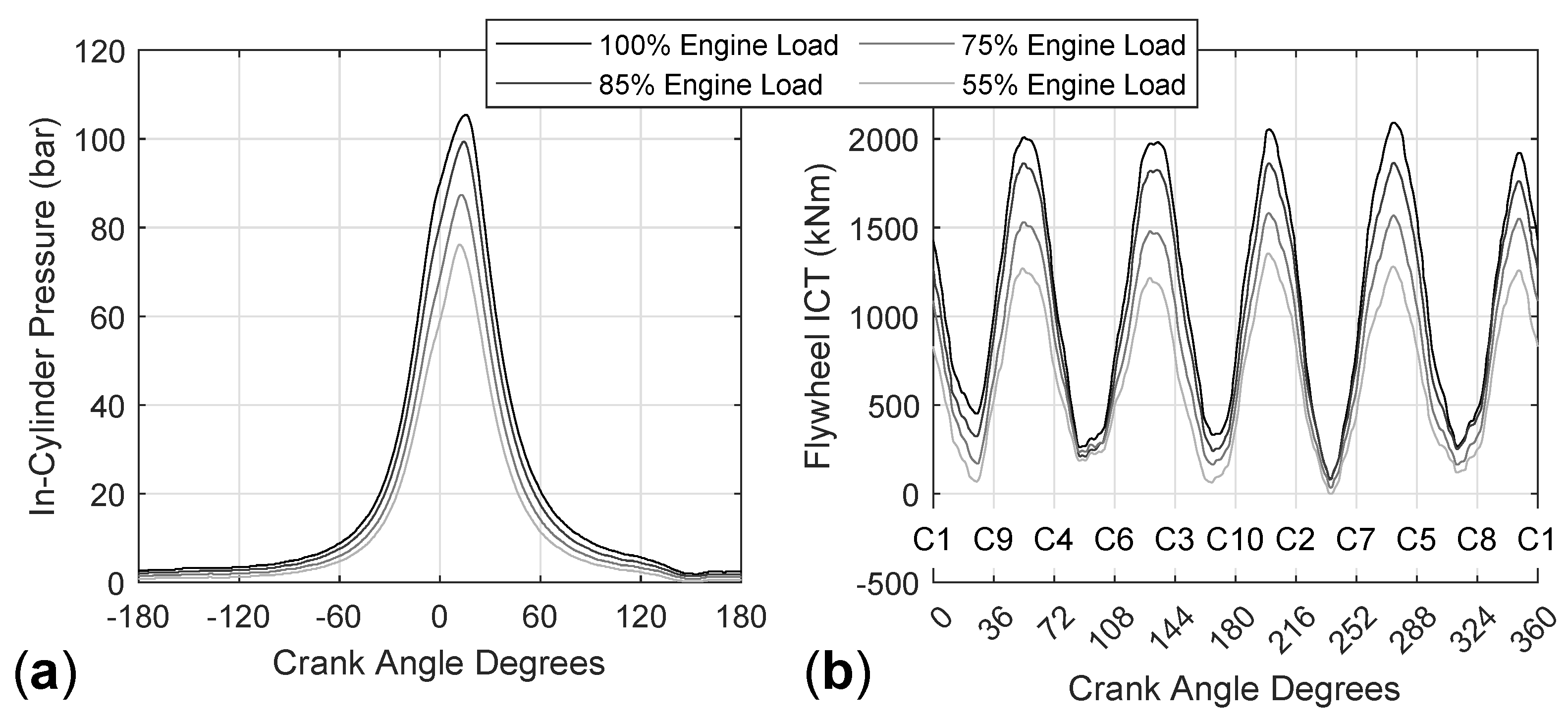
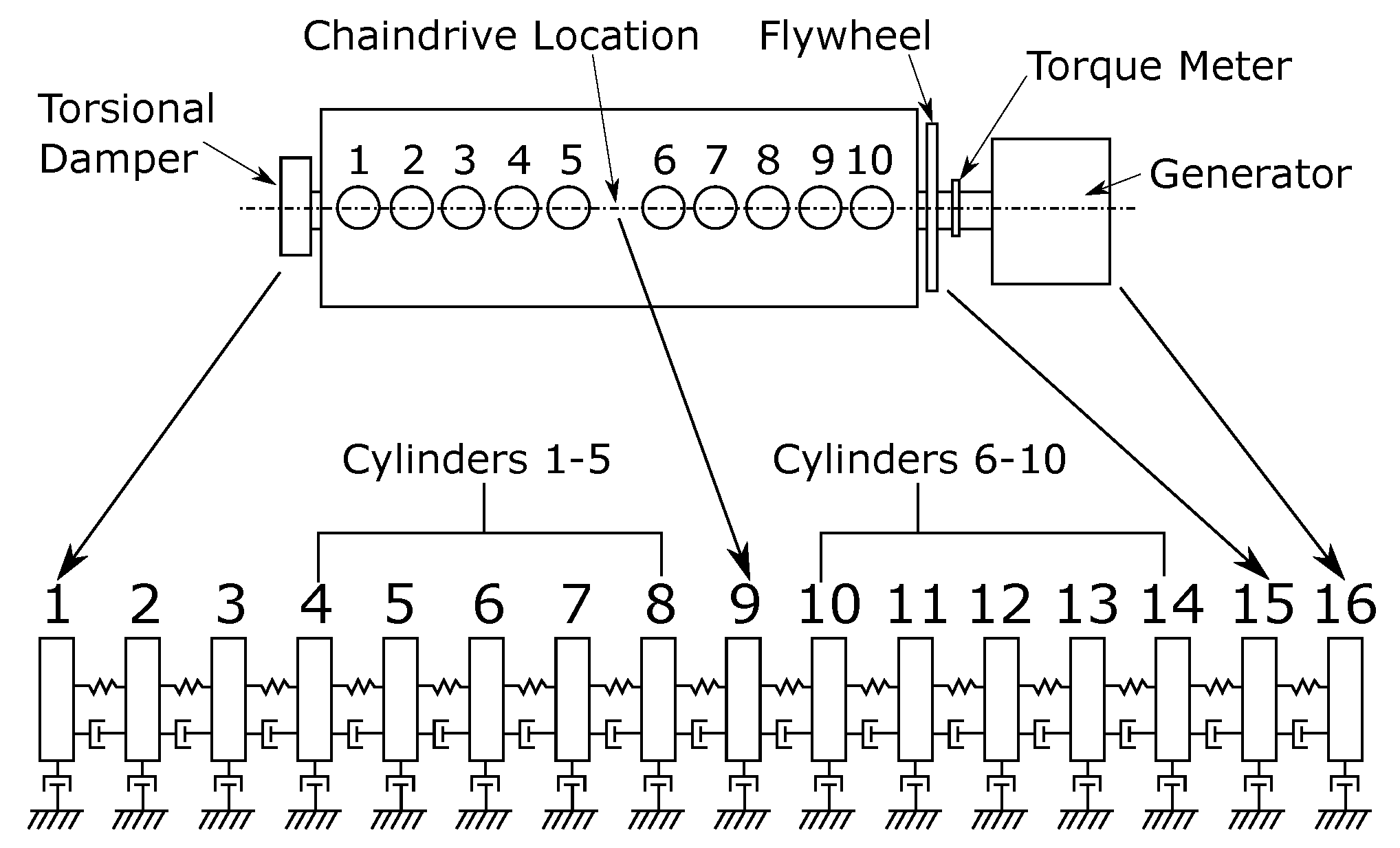
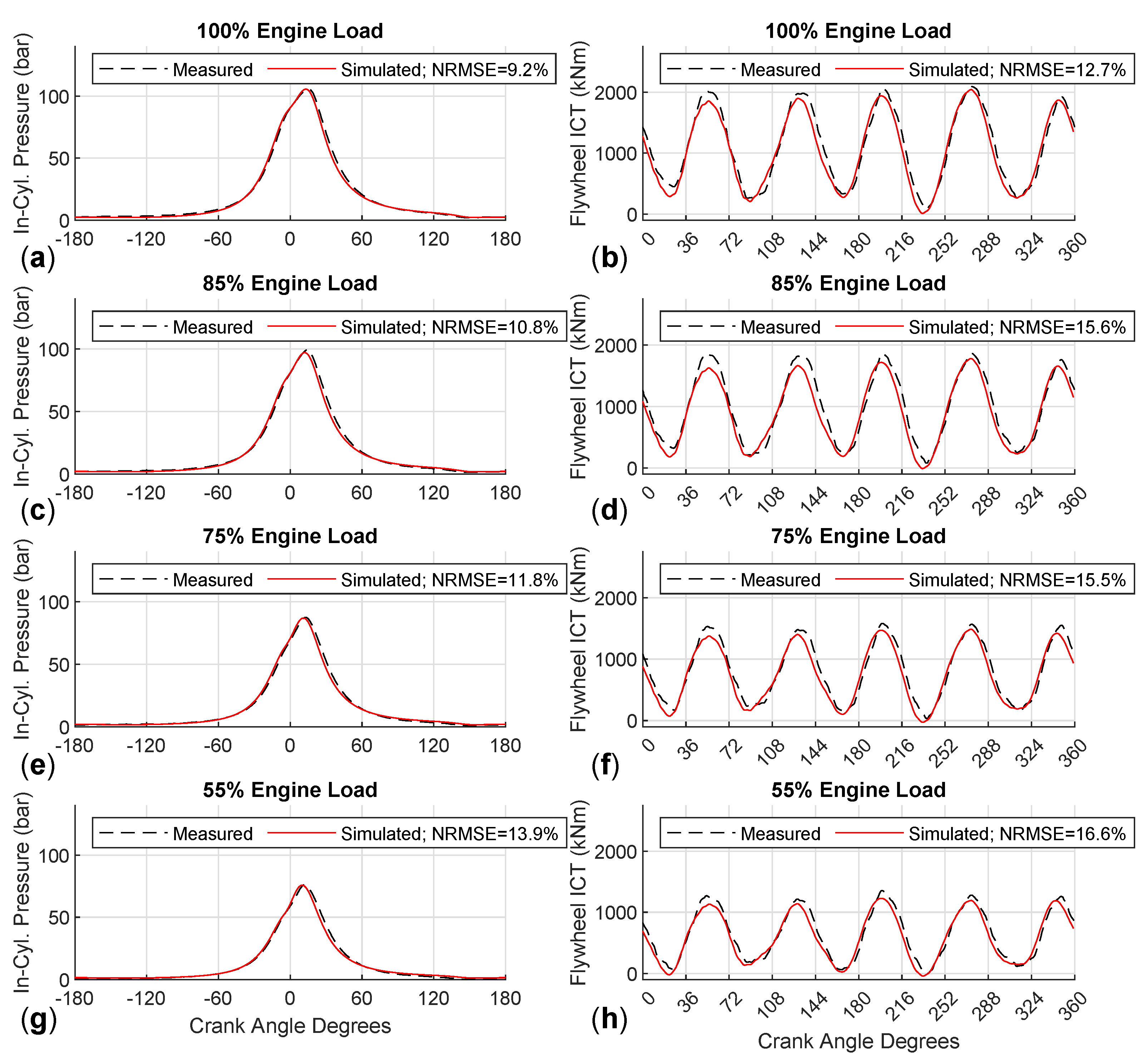
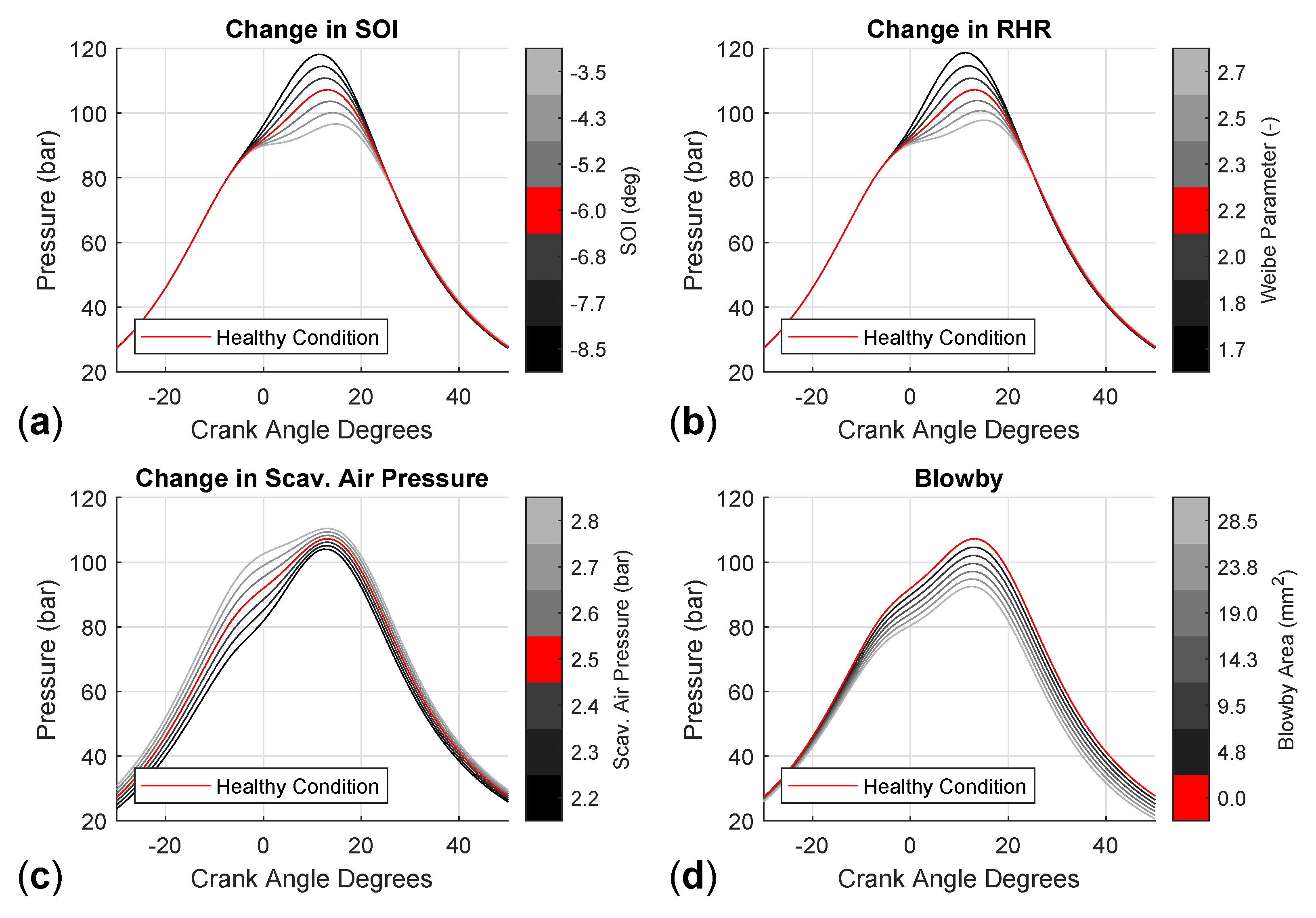

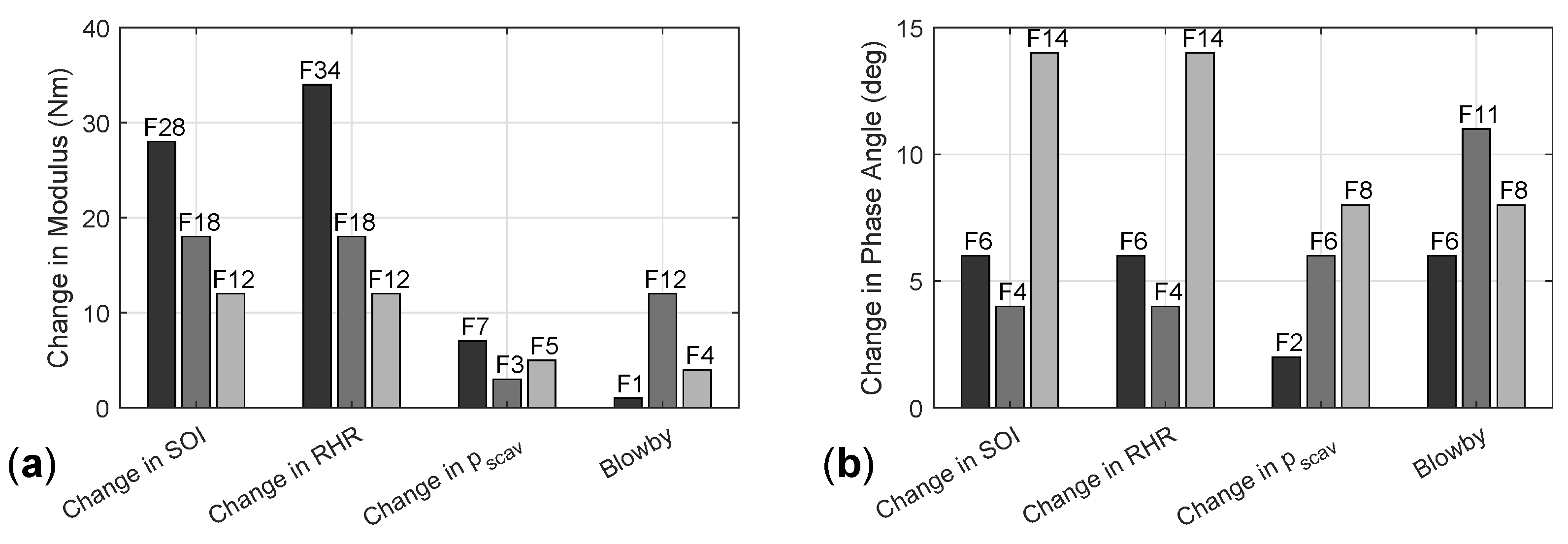
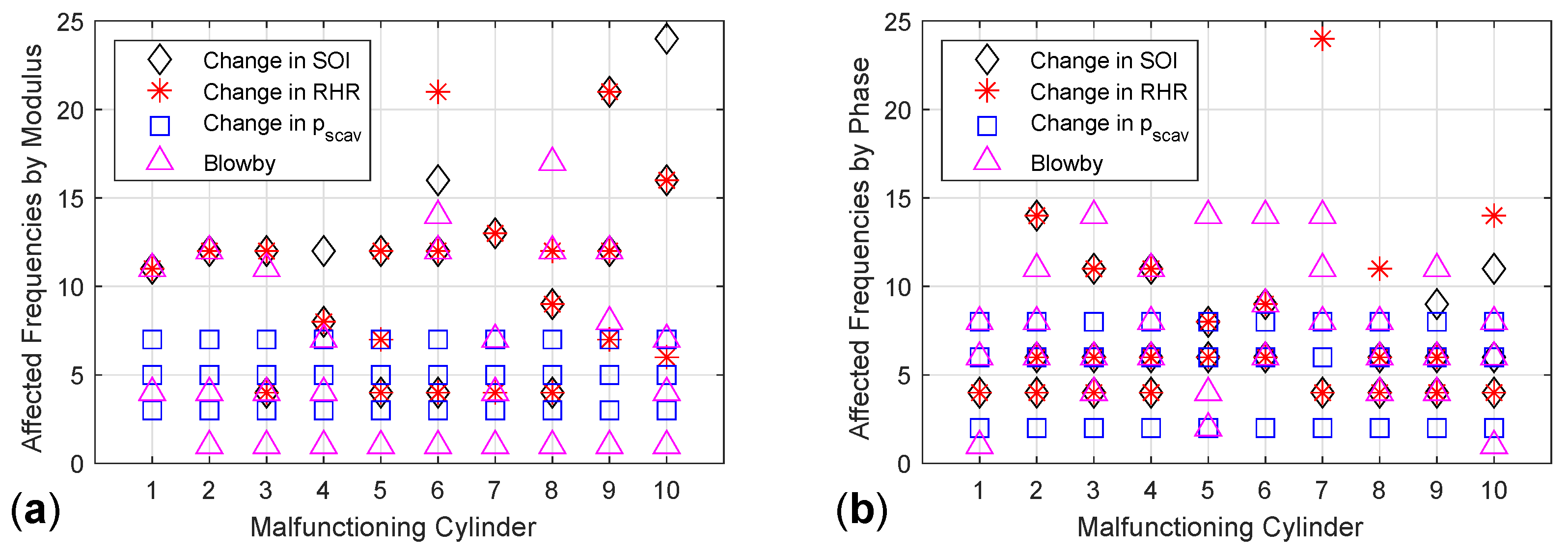
| Maximum Continuous Rating | 15.50 MW |
| Number of cylinders | 10 |
| Nominal rotational speed | 125 rev/min |
| Piston bore | 0.67 m |
| Stroke | 1.70 m |
| Firing order | 1-9-4-6-3-10-2-7-5-8 |
| Malfunctioning Condition | Changed Parameter | Parameter Range | Parameter Step |
|---|---|---|---|
| Change in SOI | Start of Combustion () | ||
| Change in RHR | Weibe shape parameter (w) | ||
| Change in scavenge air pressure | Scavenge air pressure | bar | bar |
| Blowby | Blowby effective area | mm | mm |
Publisher’s Note: MDPI stays neutral with regard to jurisdictional claims in published maps and institutional affiliations. |
© 2021 by the authors. Licensee MDPI, Basel, Switzerland. This article is an open access article distributed under the terms and conditions of the Creative Commons Attribution (CC BY) license (https://creativecommons.org/licenses/by/4.0/).
Share and Cite
Tsitsilonis, K.-M.; Theotokatos, G. Engine Malfunctioning Conditions Identification through Instantaneous Crankshaft Torque Measurement Analysis. Appl. Sci. 2021, 11, 3522. https://doi.org/10.3390/app11083522
Tsitsilonis K-M, Theotokatos G. Engine Malfunctioning Conditions Identification through Instantaneous Crankshaft Torque Measurement Analysis. Applied Sciences. 2021; 11(8):3522. https://doi.org/10.3390/app11083522
Chicago/Turabian StyleTsitsilonis, Konstantinos-Marios, and Gerasimos Theotokatos. 2021. "Engine Malfunctioning Conditions Identification through Instantaneous Crankshaft Torque Measurement Analysis" Applied Sciences 11, no. 8: 3522. https://doi.org/10.3390/app11083522
APA StyleTsitsilonis, K.-M., & Theotokatos, G. (2021). Engine Malfunctioning Conditions Identification through Instantaneous Crankshaft Torque Measurement Analysis. Applied Sciences, 11(8), 3522. https://doi.org/10.3390/app11083522







